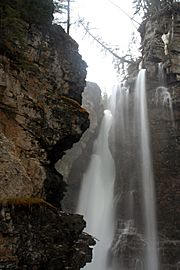Johnston Creek (Alberta) facts for kids
Quick facts for kids Johnston Creek |
|
|---|---|

Upper Falls in Johnston Canyon
|
|
| Country | Canada |
| Province | Alberta |
| Physical characteristics | |
| Main source | Badger Pass, Pulsatilla Pass 2,500 meters (8,200 ft) 51°23′38″N 115°56′52″W / 51.3938°N 115.9478°W |
| River mouth | Bow River 1,440 meters (4,720 ft) 51°14′30″N 115°51′16″W / 51.2417°N 115.8544°W |
Johnston Creek is a beautiful stream that flows into the Bow River in the amazing Canadian Rockies in Canada. You can find this creek inside Banff National Park, a famous place for nature lovers.
Contents
Where Johnston Creek Begins and Flows
Johnston Creek starts high up in the mountains, north of a peak called Castle Mountain. It begins in a valley shaped by glaciers from the Ice Age, near Badger Pass and Pulsatilla Pass. The water here is about 2,500 meters (8,200 ft) above sea level.
The creek then flows southeast between Helena Ridge and the Sawback Range. After this, it turns south and carves its way through a deep, narrow valley known as Johnston Canyon. Finally, the creek joins the Bow River south of Castle Mountain, between the towns of Banff and Lake Louise. At this point, the water is about 1,440 meters (4,720 ft) above sea level.
Exploring Johnston Canyon's Wonders
As Johnston Creek gets closer to the Bow River, it flows through a huge canyon. This canyon was formed over thousands of years as the creek slowly wore away the limestone rock. The water has created steep canyon walls, beautiful waterfalls, natural tunnels, and calm pools.
A very popular hiking trail follows the canyon. This trail eventually leads to a peaceful meadow in the Johnston Valley, located above the canyon. The first part of the trail is an easy walk on a built pathway with safety rails and bridges. The later part of the trail is more natural and a bit rougher.
The Ink Pots
Within the meadow, you'll find a special spot called the Ink Pots. These are six pools of water that are a unique blue-green color. They are fed by natural springs.
Protecting Wildlife
In August 2018, some of the natural trails near the waterfalls were temporarily closed. This was done to help protect a small group of American black swift birds that nest there. It's important to give these birds space to raise their young.
Winter Fun
When winter arrives, the waterfalls in Johnston Canyon freeze solid. This makes them a perfect spot for ice climbing, which is a popular and exciting activity for many people.
Visitor Information
At the start of the canyon, close to where the creek meets the Bow River, there's a place for visitors to stay and a large parking area. This spot is conveniently located along the Bow Valley Parkway (Highway 1A).
Gallery







